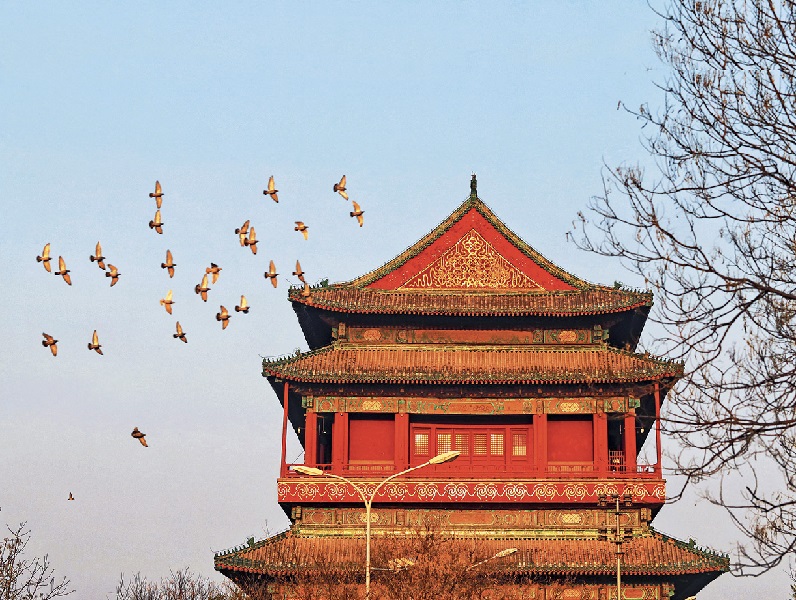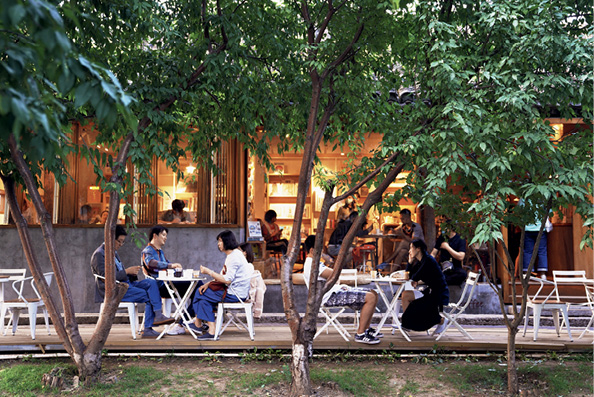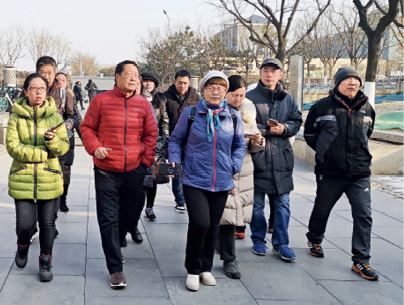The Central Axis of Beijing, running though the city, retains the memories of a generation.

A flock of pigeons flying over the Drum Tower in Beijing on April 4, 2019.
I was born and raised in Majuan Hutong, which lies to the northeast of the Forbidden City in Beijing. Across from my home’s courtyard was Caoduo Hutong. Walking west out of Caoduo Hutong, you can see the northeastern corner tower of the Forbidden City and its moat, with Jingshan Park opposite the moat.
When I was eight or nine years old, my friends and I often climbed up to the top of the Jingshan Hill, where we caught cicadas, dragonflies or crickets, and at night, we would go to watch an open-air movie.
Walking south to Qihelou Street and then heading west lies Beichizi Street. On the south is Naizifu Hutong and on the north Niuniufang Hutong. Menggongfu Hutong is also around. Later on in life, I learned that historically each of these areas once had a specific purpose. Majuan was for breeding imperial horses, Caoduo for storing fodder, Naizifu for providing breast milk for young emperors, and Niuniufang for accommodating maids.

People enjoy a leisurely moment sipping a beverage at a quaint cafè nestled amidst the hustle and bustle of Sanlihe, Qianmen on October 1, 2021.
As a boy, I only knew that my home was very close to the Forbidden City, and I had no idea that it was the center of the Beijing city and its central axis.
Whenever my relatives came to Beijing, I was their tour guide. In the early 1960s, Beijing received only a few tourists. I would take them to climb the Jingshan Hill and overlook the spectacular Forbidden City. We then moved on from Jingshan Park through the west gate to the east gate of Beihai Park, leaving through its south gate to the Gate of Divine Prowess of the Forbidden City, and exiting through the Meridian Gate. After that, a right turn led to the Zhongshan Park, also known as the Imperial Divine Temple, via its east gate. We exited the Zhongshan Park through its south gate, then turned left, crossed the Outer Golden Water Bridge in Tian'anmen Square, and arrived at the south gate of the Beijing Working People’s Cultural Palace, previously called the Imperial Ancestral Temple. Finally, our tour would come to an end as we walked along the moat in the southeast, then passed through the Beichizi Street outside the East Gate of the Forbidden City, and arrived home.
Friends and relatives were always complimentary about my tours. Back then, I knew that near my home was a splendid palace that awed the world. What was also magnificent is the Central Axis stretching from the north to the south of Beijing, and the symmetrical layout of an ancient city featuring Zuozu Youshe, which means the right side of the palace is the altar of shrines, and the left is the Imperial Ancestral Temple.

The author (in the red jacket) introduces historical sites along the southern part of the Central Axis to senior tour guides at Yongding Gate in 2019.
In the early 1980s, I worked as an intern at China International Travel Service Limited after graduating from Peking University, where I studied French. I began my tour guide profession by receiving teachers and students from MINES ParisTech, introducing them to Tian'anmen Square, the largest downtown city square in the world that stands on the Central Axis of Beijing, and the Forbidden City, hailed as the sea of palaces. I left a deep impression on them. In retrospect, it was probably at that moment that I became interested in the history of the Central Axis.
In 2003, I gave a public lecture in Wangfujing Bookstore, talking about Beijing’s Central Axis that starts at the Bell Tower and Drum Tower and ends at the Yongding Gate, passing several historical sites and serving as the central line of the spatial layout of the city. I think that the Central Axis reflects the wisdom of the Chinese nation, embodies the country’s unique spiritual values, ideologies and imagination, and demonstrates the life and creativity of the Chinese people.
After the Central Axis of Beijing had its application for a UNESCO World Heritage site confirmed, I established Beijing Central Axis Research Institute in March 2021, along with several experts on the subject. Our research centers on the culture of the ancient capital, imperial families, ancient sacrifices, and folk traditions. We aim to introduce our findings and the knowledge of the Central Axis of Beijing to the public through online and multimedia platforms. The enthusiastic support for our live-streaming continues to keep us motivated.
I’m turning 70, but the old memories of growing up in central Beijing have only grown clearer. The Central Axis of Beijing was part of my childhood and youth, and threads its way through all my memories of Beijing, like “Zuozu Youshe,” Jingshan Hill, and the Forbidden City. It also enlightens my thoughts about the culture and history of the capital. Recently, I have participated in a series of research and study activities for children and young people regarding the Central Axis. I hope to integrate my knowledge of the Central Axis and its culture with the lives of young people, passing on its stories to the next generation. 
CAO JINGZHOU is director of the expert panel on Central Axis study at the Beijing Institute of Urban Development.